Finance: Capital Structure & Dividend Policy Analysis Report
VerifiedAdded on 2023/06/12
|7
|849
|419
Report
AI Summary
This report provides an analysis of capital structure and dividend policy, focusing on the Royal Bank of Canada. It examines the bank's sources of funds for financing debt, including lease commitments, bonds, and deposit notes. The report also investigates the bank's dividend policy, noting an increasing trend in dividend per share and attributing this to a regular dividend policy driven by consistent earnings from various sectors. Furthermore, the implications of increased dividend payments on market investors and the bank's strategies for maintaining a stable dividend policy are discussed. The report references financial data and publications to support its findings and analysis.
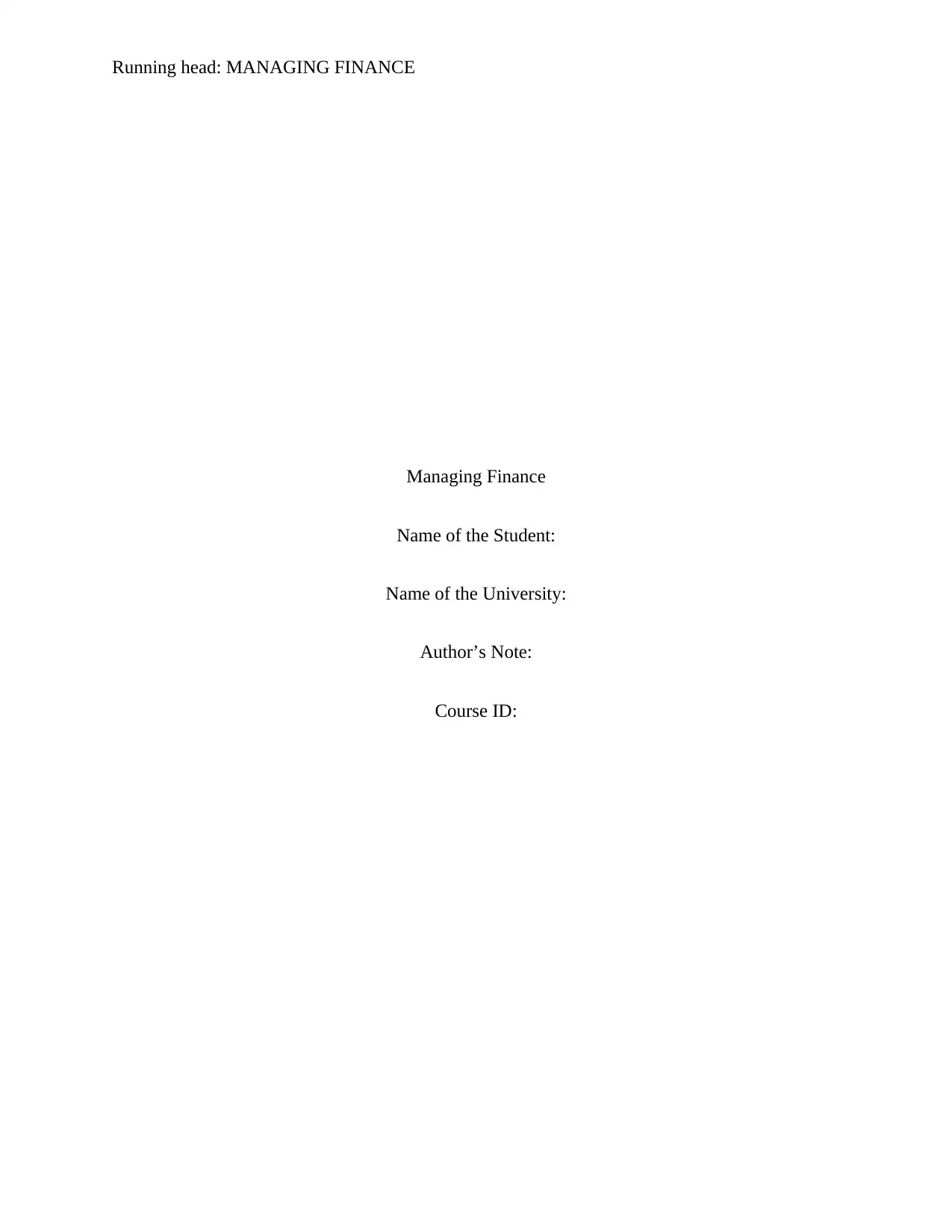
Running head: MANAGING FINANCE
Managing Finance
Name of the Student:
Name of the University:
Author’s Note:
Course ID:
Managing Finance
Name of the Student:
Name of the University:
Author’s Note:
Course ID:
Paraphrase This Document
Need a fresh take? Get an instant paraphrase of this document with our AI Paraphraser
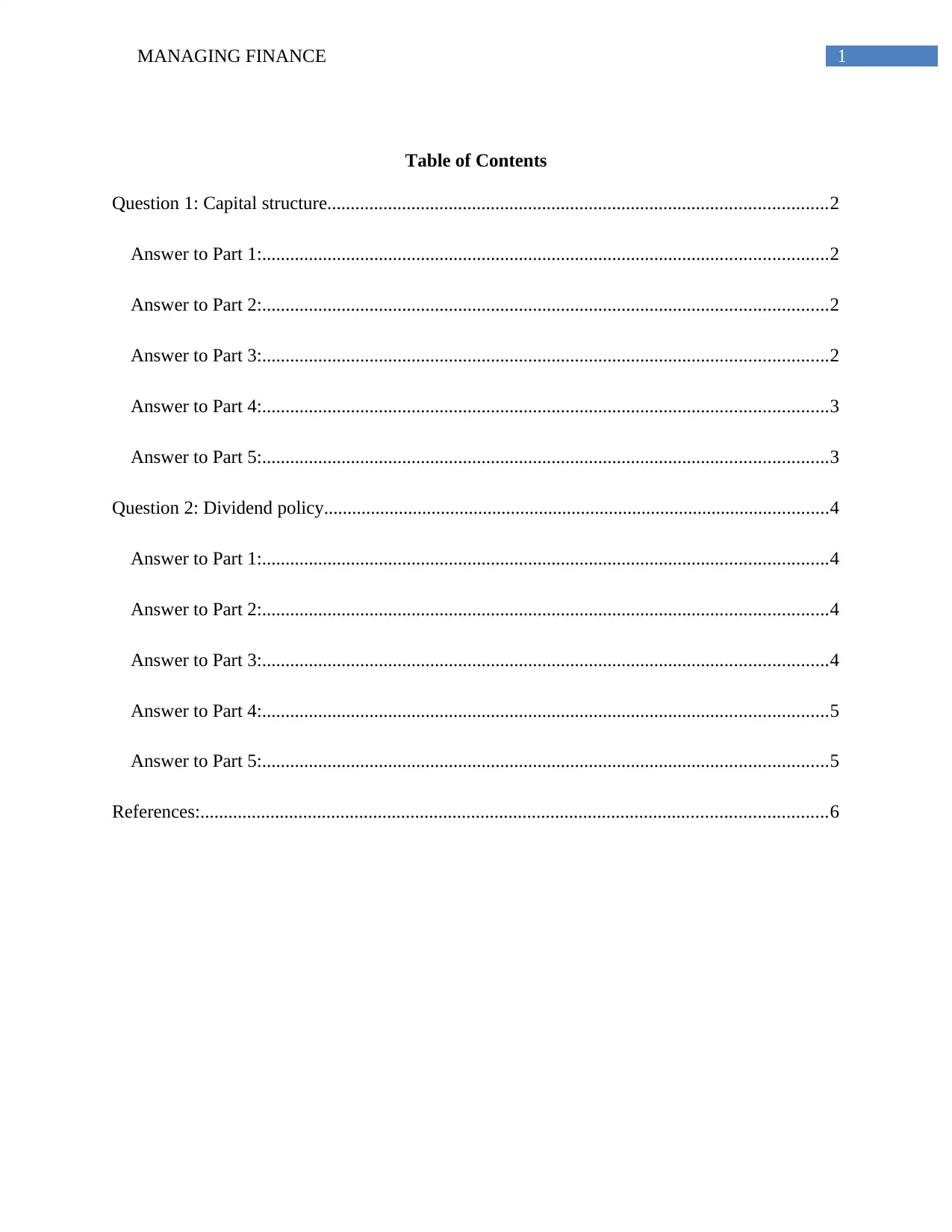
1MANAGING FINANCE
Table of Contents
Question 1: Capital structure...........................................................................................................2
Answer to Part 1:.........................................................................................................................2
Answer to Part 2:.........................................................................................................................2
Answer to Part 3:.........................................................................................................................2
Answer to Part 4:.........................................................................................................................3
Answer to Part 5:.........................................................................................................................3
Question 2: Dividend policy............................................................................................................4
Answer to Part 1:.........................................................................................................................4
Answer to Part 2:.........................................................................................................................4
Answer to Part 3:.........................................................................................................................4
Answer to Part 4:.........................................................................................................................5
Answer to Part 5:.........................................................................................................................5
References:......................................................................................................................................6
Table of Contents
Question 1: Capital structure...........................................................................................................2
Answer to Part 1:.........................................................................................................................2
Answer to Part 2:.........................................................................................................................2
Answer to Part 3:.........................................................................................................................2
Answer to Part 4:.........................................................................................................................3
Answer to Part 5:.........................................................................................................................3
Question 2: Dividend policy............................................................................................................4
Answer to Part 1:.........................................................................................................................4
Answer to Part 2:.........................................................................................................................4
Answer to Part 3:.........................................................................................................................4
Answer to Part 4:.........................................................................................................................5
Answer to Part 5:.........................................................................................................................5
References:......................................................................................................................................6
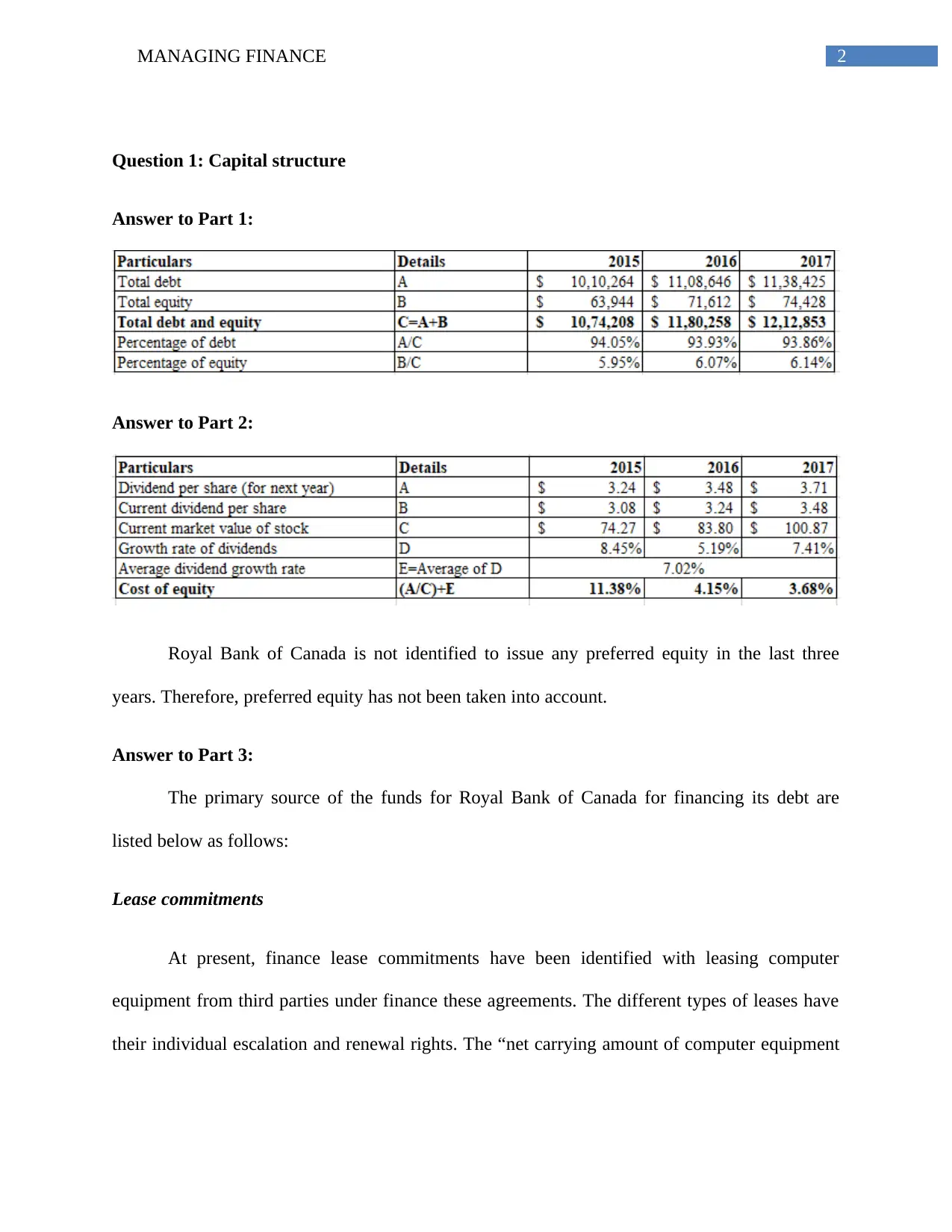
2MANAGING FINANCE
Question 1: Capital structure
Answer to Part 1:
Answer to Part 2:
Royal Bank of Canada is not identified to issue any preferred equity in the last three
years. Therefore, preferred equity has not been taken into account.
Answer to Part 3:
The primary source of the funds for Royal Bank of Canada for financing its debt are
listed below as follows:
Lease commitments
At present, finance lease commitments have been identified with leasing computer
equipment from third parties under finance these agreements. The different types of leases have
their individual escalation and renewal rights. The “net carrying amount of computer equipment
Question 1: Capital structure
Answer to Part 1:
Answer to Part 2:
Royal Bank of Canada is not identified to issue any preferred equity in the last three
years. Therefore, preferred equity has not been taken into account.
Answer to Part 3:
The primary source of the funds for Royal Bank of Canada for financing its debt are
listed below as follows:
Lease commitments
At present, finance lease commitments have been identified with leasing computer
equipment from third parties under finance these agreements. The different types of leases have
their individual escalation and renewal rights. The “net carrying amount of computer equipment
⊘ This is a preview!⊘
Do you want full access?
Subscribe today to unlock all pages.

Trusted by 1+ million students worldwide
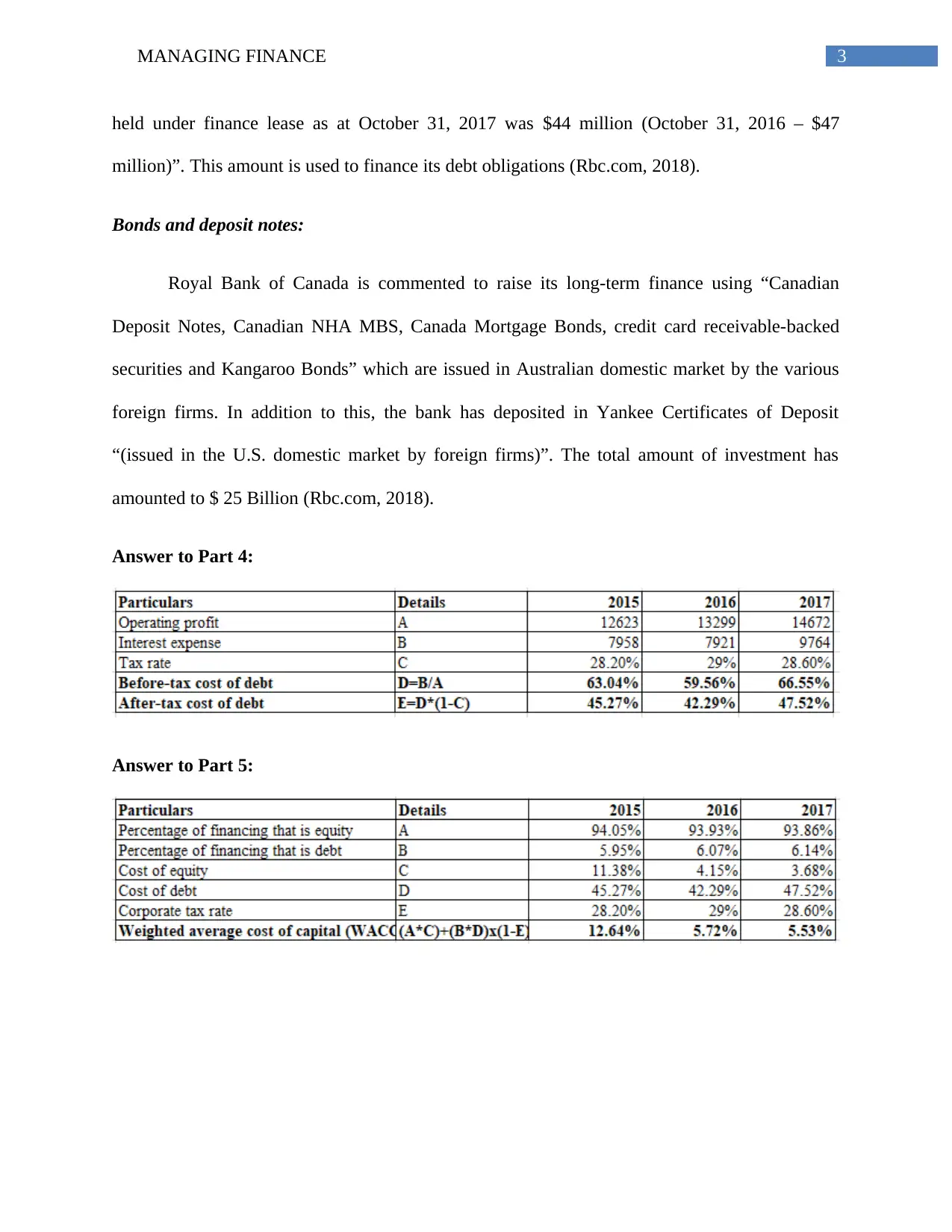
3MANAGING FINANCE
held under finance lease as at October 31, 2017 was $44 million (October 31, 2016 – $47
million)”. This amount is used to finance its debt obligations (Rbc.com, 2018).
Bonds and deposit notes:
Royal Bank of Canada is commented to raise its long-term finance using “Canadian
Deposit Notes, Canadian NHA MBS, Canada Mortgage Bonds, credit card receivable-backed
securities and Kangaroo Bonds” which are issued in Australian domestic market by the various
foreign firms. In addition to this, the bank has deposited in Yankee Certificates of Deposit
“(issued in the U.S. domestic market by foreign firms)”. The total amount of investment has
amounted to $ 25 Billion (Rbc.com, 2018).
Answer to Part 4:
Answer to Part 5:
held under finance lease as at October 31, 2017 was $44 million (October 31, 2016 – $47
million)”. This amount is used to finance its debt obligations (Rbc.com, 2018).
Bonds and deposit notes:
Royal Bank of Canada is commented to raise its long-term finance using “Canadian
Deposit Notes, Canadian NHA MBS, Canada Mortgage Bonds, credit card receivable-backed
securities and Kangaroo Bonds” which are issued in Australian domestic market by the various
foreign firms. In addition to this, the bank has deposited in Yankee Certificates of Deposit
“(issued in the U.S. domestic market by foreign firms)”. The total amount of investment has
amounted to $ 25 Billion (Rbc.com, 2018).
Answer to Part 4:
Answer to Part 5:
Paraphrase This Document
Need a fresh take? Get an instant paraphrase of this document with our AI Paraphraser
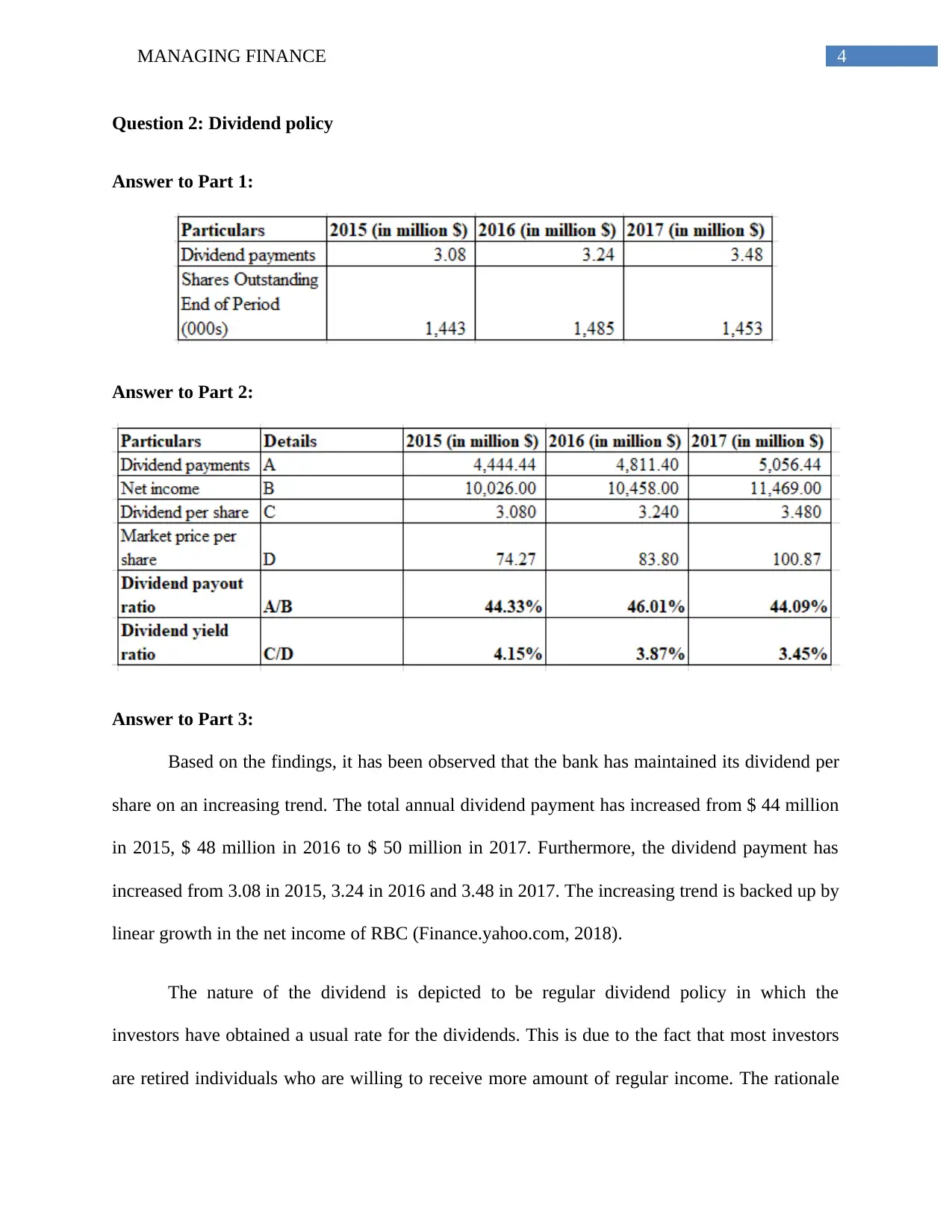
4MANAGING FINANCE
Question 2: Dividend policy
Answer to Part 1:
Answer to Part 2:
Answer to Part 3:
Based on the findings, it has been observed that the bank has maintained its dividend per
share on an increasing trend. The total annual dividend payment has increased from $ 44 million
in 2015, $ 48 million in 2016 to $ 50 million in 2017. Furthermore, the dividend payment has
increased from 3.08 in 2015, 3.24 in 2016 and 3.48 in 2017. The increasing trend is backed up by
linear growth in the net income of RBC (Finance.yahoo.com, 2018).
The nature of the dividend is depicted to be regular dividend policy in which the
investors have obtained a usual rate for the dividends. This is due to the fact that most investors
are retired individuals who are willing to receive more amount of regular income. The rationale
Question 2: Dividend policy
Answer to Part 1:
Answer to Part 2:
Answer to Part 3:
Based on the findings, it has been observed that the bank has maintained its dividend per
share on an increasing trend. The total annual dividend payment has increased from $ 44 million
in 2015, $ 48 million in 2016 to $ 50 million in 2017. Furthermore, the dividend payment has
increased from 3.08 in 2015, 3.24 in 2016 and 3.48 in 2017. The increasing trend is backed up by
linear growth in the net income of RBC (Finance.yahoo.com, 2018).
The nature of the dividend is depicted to be regular dividend policy in which the
investors have obtained a usual rate for the dividends. This is due to the fact that most investors
are retired individuals who are willing to receive more amount of regular income. The rationale
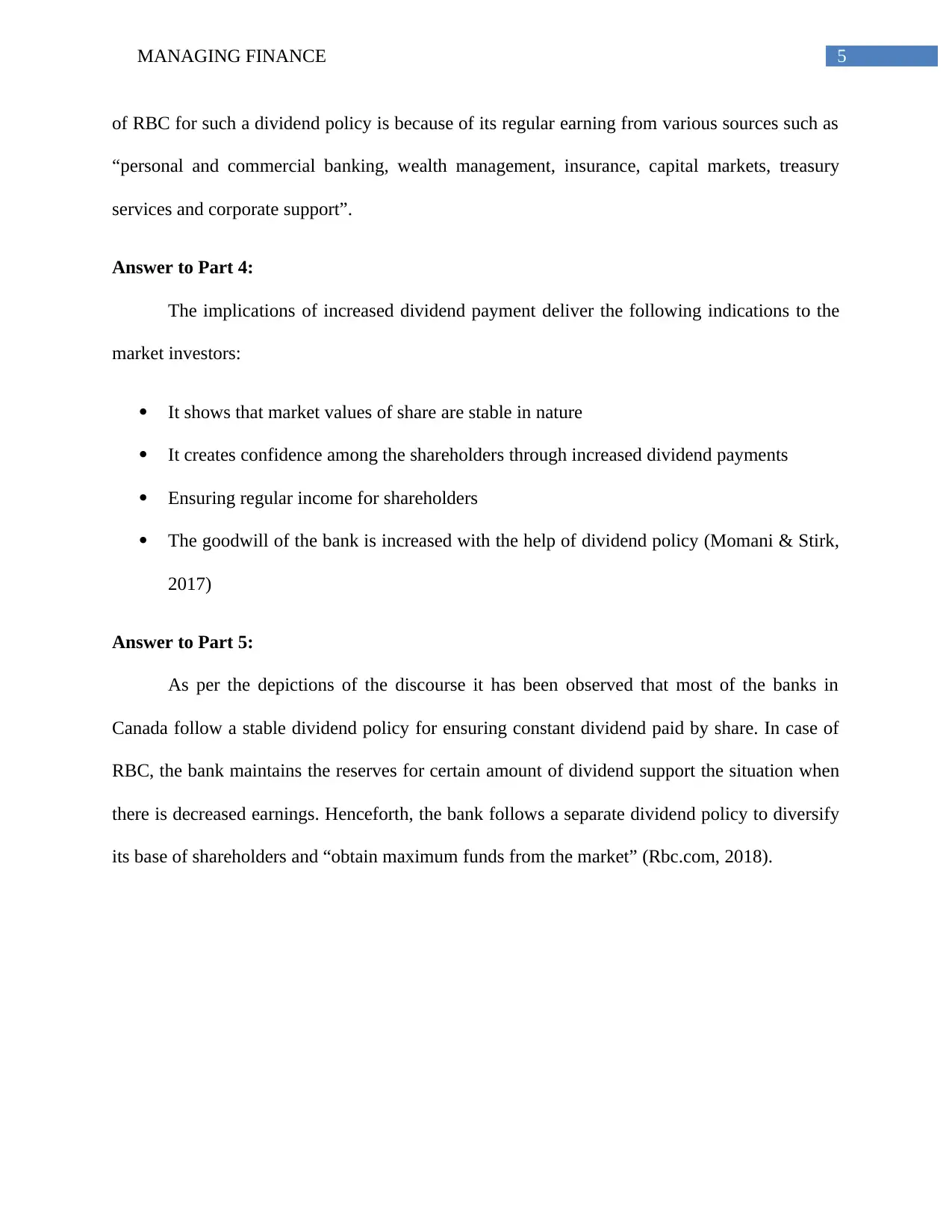
5MANAGING FINANCE
of RBC for such a dividend policy is because of its regular earning from various sources such as
“personal and commercial banking, wealth management, insurance, capital markets, treasury
services and corporate support”.
Answer to Part 4:
The implications of increased dividend payment deliver the following indications to the
market investors:
It shows that market values of share are stable in nature
It creates confidence among the shareholders through increased dividend payments
Ensuring regular income for shareholders
The goodwill of the bank is increased with the help of dividend policy (Momani & Stirk,
2017)
Answer to Part 5:
As per the depictions of the discourse it has been observed that most of the banks in
Canada follow a stable dividend policy for ensuring constant dividend paid by share. In case of
RBC, the bank maintains the reserves for certain amount of dividend support the situation when
there is decreased earnings. Henceforth, the bank follows a separate dividend policy to diversify
its base of shareholders and “obtain maximum funds from the market” (Rbc.com, 2018).
of RBC for such a dividend policy is because of its regular earning from various sources such as
“personal and commercial banking, wealth management, insurance, capital markets, treasury
services and corporate support”.
Answer to Part 4:
The implications of increased dividend payment deliver the following indications to the
market investors:
It shows that market values of share are stable in nature
It creates confidence among the shareholders through increased dividend payments
Ensuring regular income for shareholders
The goodwill of the bank is increased with the help of dividend policy (Momani & Stirk,
2017)
Answer to Part 5:
As per the depictions of the discourse it has been observed that most of the banks in
Canada follow a stable dividend policy for ensuring constant dividend paid by share. In case of
RBC, the bank maintains the reserves for certain amount of dividend support the situation when
there is decreased earnings. Henceforth, the bank follows a separate dividend policy to diversify
its base of shareholders and “obtain maximum funds from the market” (Rbc.com, 2018).
⊘ This is a preview!⊘
Do you want full access?
Subscribe today to unlock all pages.

Trusted by 1+ million students worldwide
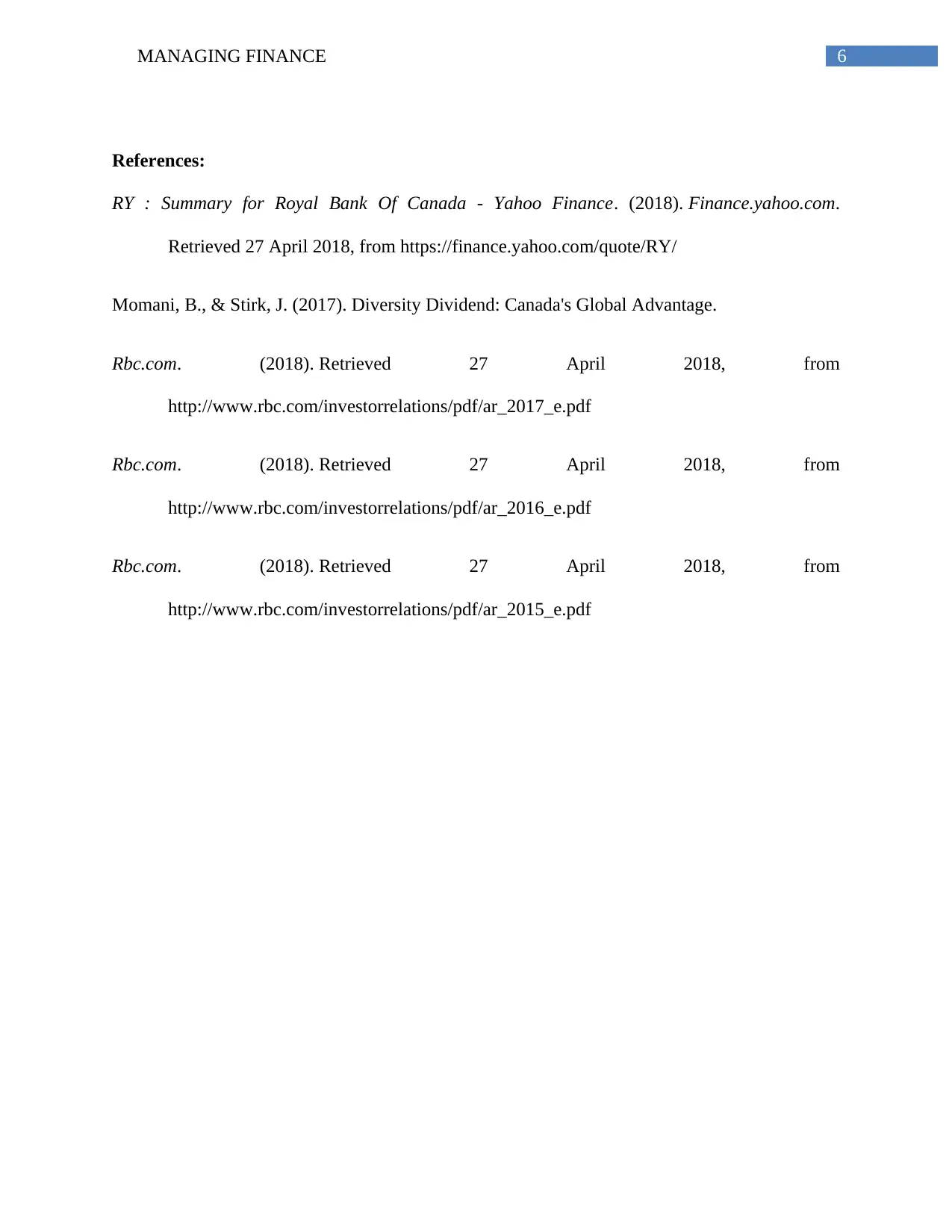
6MANAGING FINANCE
References:
RY : Summary for Royal Bank Of Canada - Yahoo Finance. (2018). Finance.yahoo.com.
Retrieved 27 April 2018, from https://finance.yahoo.com/quote/RY/
Momani, B., & Stirk, J. (2017). Diversity Dividend: Canada's Global Advantage.
Rbc.com. (2018). Retrieved 27 April 2018, from
http://www.rbc.com/investorrelations/pdf/ar_2017_e.pdf
Rbc.com. (2018). Retrieved 27 April 2018, from
http://www.rbc.com/investorrelations/pdf/ar_2016_e.pdf
Rbc.com. (2018). Retrieved 27 April 2018, from
http://www.rbc.com/investorrelations/pdf/ar_2015_e.pdf
References:
RY : Summary for Royal Bank Of Canada - Yahoo Finance. (2018). Finance.yahoo.com.
Retrieved 27 April 2018, from https://finance.yahoo.com/quote/RY/
Momani, B., & Stirk, J. (2017). Diversity Dividend: Canada's Global Advantage.
Rbc.com. (2018). Retrieved 27 April 2018, from
http://www.rbc.com/investorrelations/pdf/ar_2017_e.pdf
Rbc.com. (2018). Retrieved 27 April 2018, from
http://www.rbc.com/investorrelations/pdf/ar_2016_e.pdf
Rbc.com. (2018). Retrieved 27 April 2018, from
http://www.rbc.com/investorrelations/pdf/ar_2015_e.pdf
1 out of 7
Related Documents
Your All-in-One AI-Powered Toolkit for Academic Success.
+13062052269
info@desklib.com
Available 24*7 on WhatsApp / Email
![[object Object]](/_next/static/media/star-bottom.7253800d.svg)
Unlock your academic potential
Copyright © 2020–2025 A2Z Services. All Rights Reserved. Developed and managed by ZUCOL.




